Leadership and Change: Strategies for ABC Healthcare Organization
VerifiedAdded on 2023/03/23
|12
|4190
|94
Report
AI Summary
This report examines leadership strategies and styles in the context of ABC Healthcare Organization, a private sector company facing challenges due to increased competition. The report explores the importance of leadership in change management, highlighting how leaders can act as sponsors, set examples, establish communication channels, promote engagement, and delegate authority. It then analyzes different leadership styles, including autocratic, democratic, transactional, transformational, and servant leadership, discussing their pros and cons in driving organizational change. The report argues that effective leadership, particularly transformational leadership, is crucial for successful change implementation in healthcare organizations and provides recommendations for the organization to adopt a more effective leadership style to address its challenges and ensure a successful technology-driven transformation.
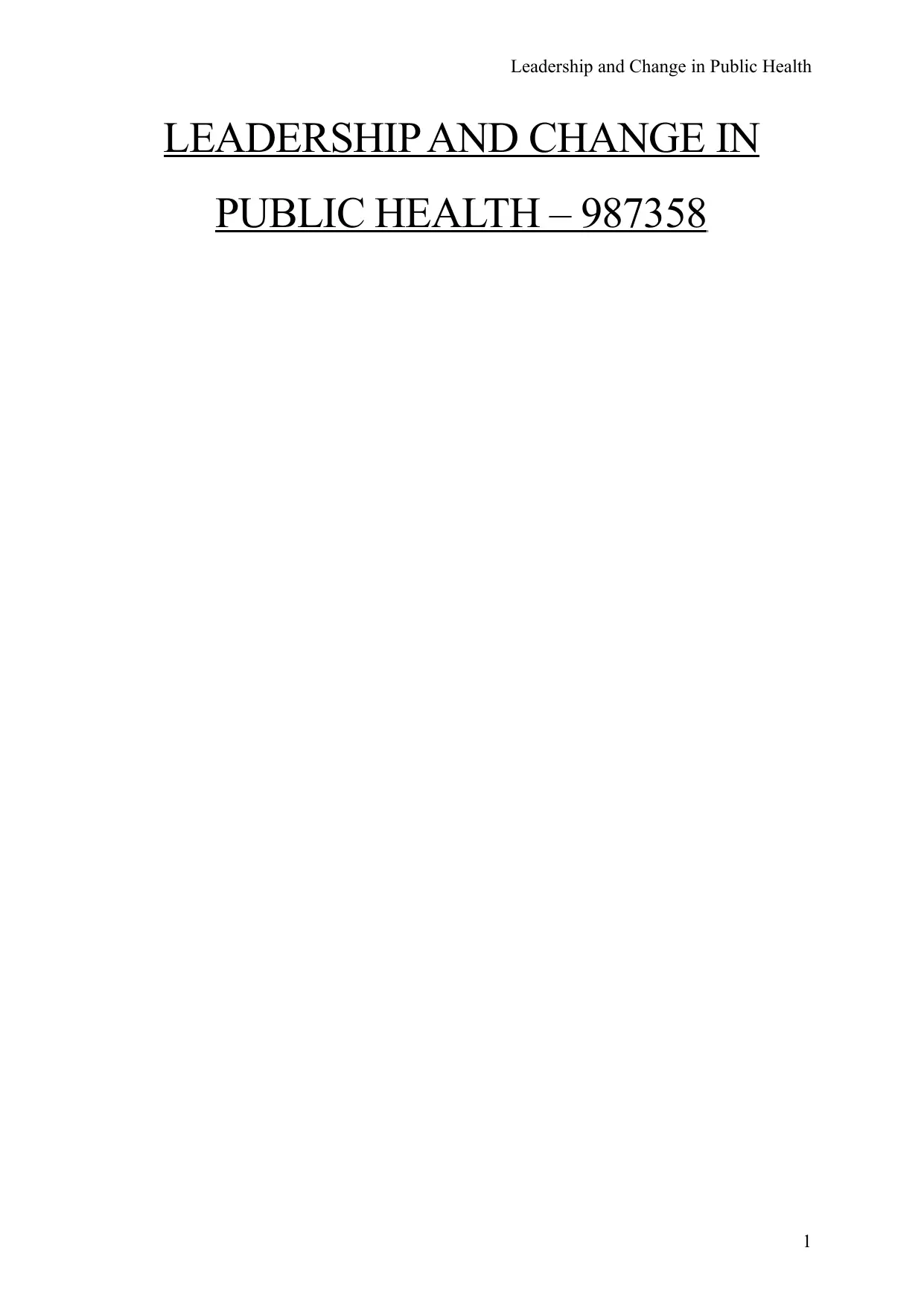
Leadership and Change in Public Health
LEADERSHIP AND CHANGE IN
PUBLIC HEALTH – 987358
1
LEADERSHIP AND CHANGE IN
PUBLIC HEALTH – 987358
1
Paraphrase This Document
Need a fresh take? Get an instant paraphrase of this document with our AI Paraphraser
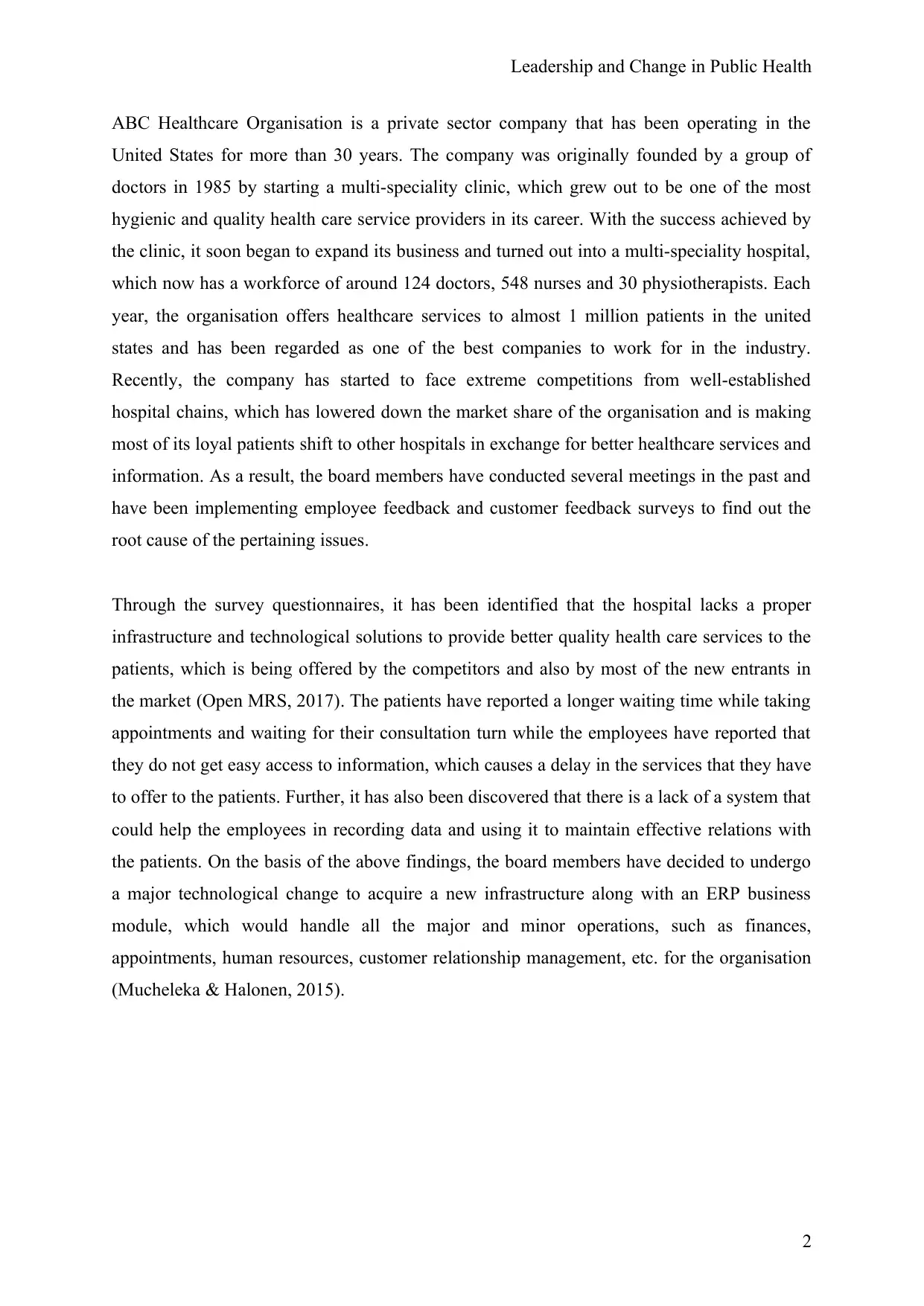
Leadership and Change in Public Health
ABC Healthcare Organisation is a private sector company that has been operating in the
United States for more than 30 years. The company was originally founded by a group of
doctors in 1985 by starting a multi-speciality clinic, which grew out to be one of the most
hygienic and quality health care service providers in its career. With the success achieved by
the clinic, it soon began to expand its business and turned out into a multi-speciality hospital,
which now has a workforce of around 124 doctors, 548 nurses and 30 physiotherapists. Each
year, the organisation offers healthcare services to almost 1 million patients in the united
states and has been regarded as one of the best companies to work for in the industry.
Recently, the company has started to face extreme competitions from well-established
hospital chains, which has lowered down the market share of the organisation and is making
most of its loyal patients shift to other hospitals in exchange for better healthcare services and
information. As a result, the board members have conducted several meetings in the past and
have been implementing employee feedback and customer feedback surveys to find out the
root cause of the pertaining issues.
Through the survey questionnaires, it has been identified that the hospital lacks a proper
infrastructure and technological solutions to provide better quality health care services to the
patients, which is being offered by the competitors and also by most of the new entrants in
the market (Open MRS, 2017). The patients have reported a longer waiting time while taking
appointments and waiting for their consultation turn while the employees have reported that
they do not get easy access to information, which causes a delay in the services that they have
to offer to the patients. Further, it has also been discovered that there is a lack of a system that
could help the employees in recording data and using it to maintain effective relations with
the patients. On the basis of the above findings, the board members have decided to undergo
a major technological change to acquire a new infrastructure along with an ERP business
module, which would handle all the major and minor operations, such as finances,
appointments, human resources, customer relationship management, etc. for the organisation
(Mucheleka & Halonen, 2015).
2
ABC Healthcare Organisation is a private sector company that has been operating in the
United States for more than 30 years. The company was originally founded by a group of
doctors in 1985 by starting a multi-speciality clinic, which grew out to be one of the most
hygienic and quality health care service providers in its career. With the success achieved by
the clinic, it soon began to expand its business and turned out into a multi-speciality hospital,
which now has a workforce of around 124 doctors, 548 nurses and 30 physiotherapists. Each
year, the organisation offers healthcare services to almost 1 million patients in the united
states and has been regarded as one of the best companies to work for in the industry.
Recently, the company has started to face extreme competitions from well-established
hospital chains, which has lowered down the market share of the organisation and is making
most of its loyal patients shift to other hospitals in exchange for better healthcare services and
information. As a result, the board members have conducted several meetings in the past and
have been implementing employee feedback and customer feedback surveys to find out the
root cause of the pertaining issues.
Through the survey questionnaires, it has been identified that the hospital lacks a proper
infrastructure and technological solutions to provide better quality health care services to the
patients, which is being offered by the competitors and also by most of the new entrants in
the market (Open MRS, 2017). The patients have reported a longer waiting time while taking
appointments and waiting for their consultation turn while the employees have reported that
they do not get easy access to information, which causes a delay in the services that they have
to offer to the patients. Further, it has also been discovered that there is a lack of a system that
could help the employees in recording data and using it to maintain effective relations with
the patients. On the basis of the above findings, the board members have decided to undergo
a major technological change to acquire a new infrastructure along with an ERP business
module, which would handle all the major and minor operations, such as finances,
appointments, human resources, customer relationship management, etc. for the organisation
(Mucheleka & Halonen, 2015).
2
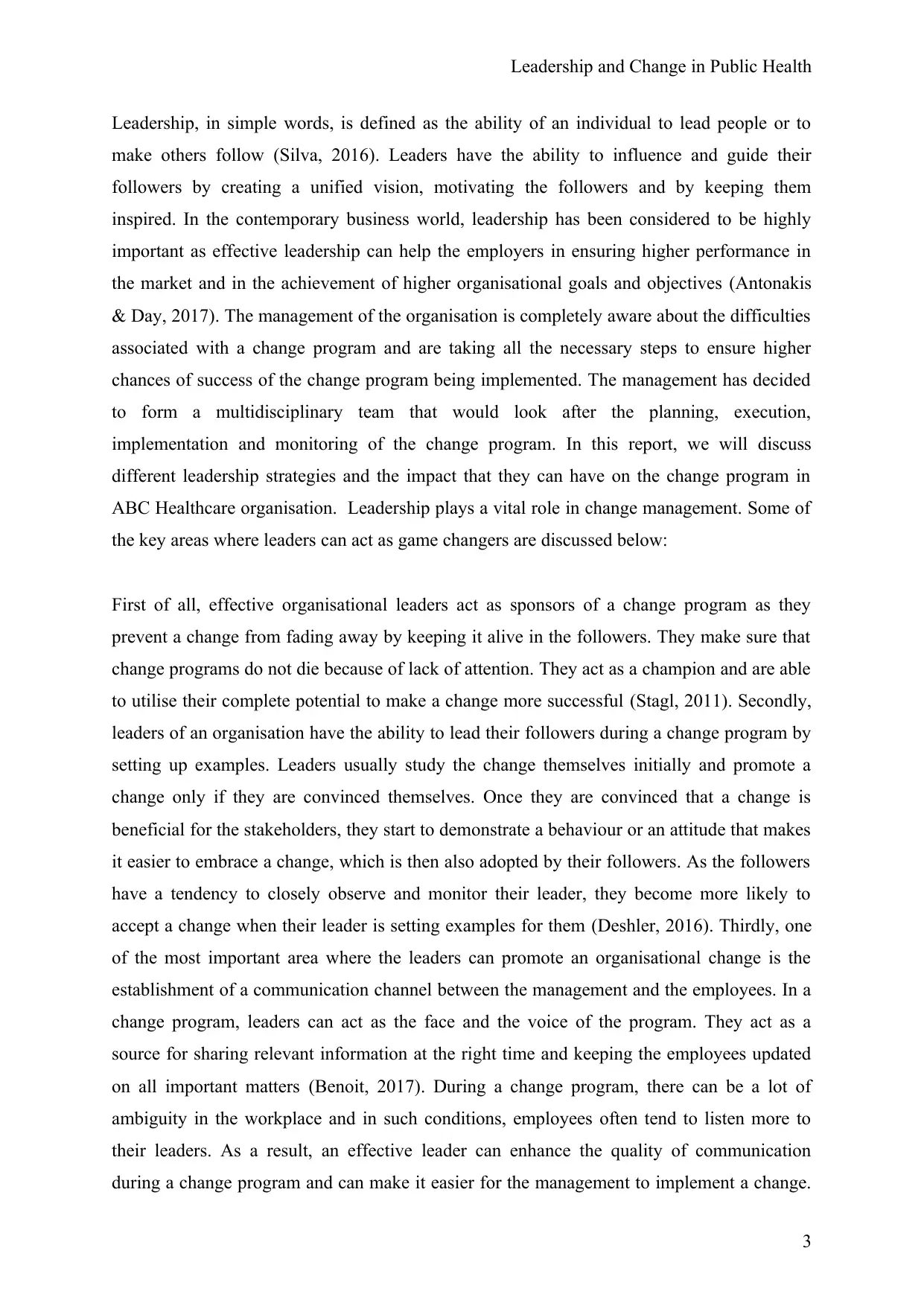
Leadership and Change in Public Health
Leadership, in simple words, is defined as the ability of an individual to lead people or to
make others follow (Silva, 2016). Leaders have the ability to influence and guide their
followers by creating a unified vision, motivating the followers and by keeping them
inspired. In the contemporary business world, leadership has been considered to be highly
important as effective leadership can help the employers in ensuring higher performance in
the market and in the achievement of higher organisational goals and objectives (Antonakis
& Day, 2017). The management of the organisation is completely aware about the difficulties
associated with a change program and are taking all the necessary steps to ensure higher
chances of success of the change program being implemented. The management has decided
to form a multidisciplinary team that would look after the planning, execution,
implementation and monitoring of the change program. In this report, we will discuss
different leadership strategies and the impact that they can have on the change program in
ABC Healthcare organisation. Leadership plays a vital role in change management. Some of
the key areas where leaders can act as game changers are discussed below:
First of all, effective organisational leaders act as sponsors of a change program as they
prevent a change from fading away by keeping it alive in the followers. They make sure that
change programs do not die because of lack of attention. They act as a champion and are able
to utilise their complete potential to make a change more successful (Stagl, 2011). Secondly,
leaders of an organisation have the ability to lead their followers during a change program by
setting up examples. Leaders usually study the change themselves initially and promote a
change only if they are convinced themselves. Once they are convinced that a change is
beneficial for the stakeholders, they start to demonstrate a behaviour or an attitude that makes
it easier to embrace a change, which is then also adopted by their followers. As the followers
have a tendency to closely observe and monitor their leader, they become more likely to
accept a change when their leader is setting examples for them (Deshler, 2016). Thirdly, one
of the most important area where the leaders can promote an organisational change is the
establishment of a communication channel between the management and the employees. In a
change program, leaders can act as the face and the voice of the program. They act as a
source for sharing relevant information at the right time and keeping the employees updated
on all important matters (Benoit, 2017). During a change program, there can be a lot of
ambiguity in the workplace and in such conditions, employees often tend to listen more to
their leaders. As a result, an effective leader can enhance the quality of communication
during a change program and can make it easier for the management to implement a change.
3
Leadership, in simple words, is defined as the ability of an individual to lead people or to
make others follow (Silva, 2016). Leaders have the ability to influence and guide their
followers by creating a unified vision, motivating the followers and by keeping them
inspired. In the contemporary business world, leadership has been considered to be highly
important as effective leadership can help the employers in ensuring higher performance in
the market and in the achievement of higher organisational goals and objectives (Antonakis
& Day, 2017). The management of the organisation is completely aware about the difficulties
associated with a change program and are taking all the necessary steps to ensure higher
chances of success of the change program being implemented. The management has decided
to form a multidisciplinary team that would look after the planning, execution,
implementation and monitoring of the change program. In this report, we will discuss
different leadership strategies and the impact that they can have on the change program in
ABC Healthcare organisation. Leadership plays a vital role in change management. Some of
the key areas where leaders can act as game changers are discussed below:
First of all, effective organisational leaders act as sponsors of a change program as they
prevent a change from fading away by keeping it alive in the followers. They make sure that
change programs do not die because of lack of attention. They act as a champion and are able
to utilise their complete potential to make a change more successful (Stagl, 2011). Secondly,
leaders of an organisation have the ability to lead their followers during a change program by
setting up examples. Leaders usually study the change themselves initially and promote a
change only if they are convinced themselves. Once they are convinced that a change is
beneficial for the stakeholders, they start to demonstrate a behaviour or an attitude that makes
it easier to embrace a change, which is then also adopted by their followers. As the followers
have a tendency to closely observe and monitor their leader, they become more likely to
accept a change when their leader is setting examples for them (Deshler, 2016). Thirdly, one
of the most important area where the leaders can promote an organisational change is the
establishment of a communication channel between the management and the employees. In a
change program, leaders can act as the face and the voice of the program. They act as a
source for sharing relevant information at the right time and keeping the employees updated
on all important matters (Benoit, 2017). During a change program, there can be a lot of
ambiguity in the workplace and in such conditions, employees often tend to listen more to
their leaders. As a result, an effective leader can enhance the quality of communication
during a change program and can make it easier for the management to implement a change.
3
⊘ This is a preview!⊘
Do you want full access?
Subscribe today to unlock all pages.

Trusted by 1+ million students worldwide
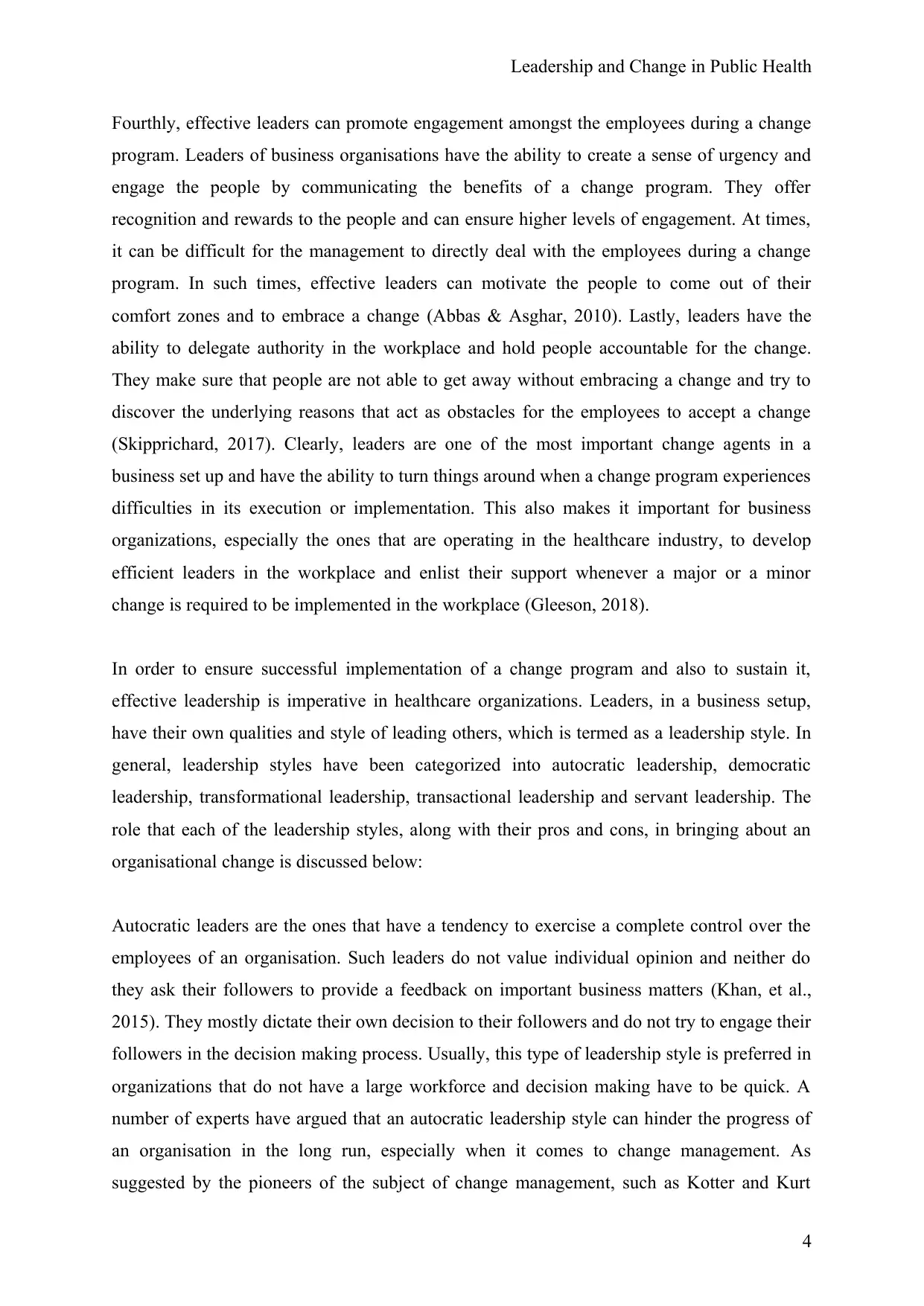
Leadership and Change in Public Health
Fourthly, effective leaders can promote engagement amongst the employees during a change
program. Leaders of business organisations have the ability to create a sense of urgency and
engage the people by communicating the benefits of a change program. They offer
recognition and rewards to the people and can ensure higher levels of engagement. At times,
it can be difficult for the management to directly deal with the employees during a change
program. In such times, effective leaders can motivate the people to come out of their
comfort zones and to embrace a change (Abbas & Asghar, 2010). Lastly, leaders have the
ability to delegate authority in the workplace and hold people accountable for the change.
They make sure that people are not able to get away without embracing a change and try to
discover the underlying reasons that act as obstacles for the employees to accept a change
(Skipprichard, 2017). Clearly, leaders are one of the most important change agents in a
business set up and have the ability to turn things around when a change program experiences
difficulties in its execution or implementation. This also makes it important for business
organizations, especially the ones that are operating in the healthcare industry, to develop
efficient leaders in the workplace and enlist their support whenever a major or a minor
change is required to be implemented in the workplace (Gleeson, 2018).
In order to ensure successful implementation of a change program and also to sustain it,
effective leadership is imperative in healthcare organizations. Leaders, in a business setup,
have their own qualities and style of leading others, which is termed as a leadership style. In
general, leadership styles have been categorized into autocratic leadership, democratic
leadership, transformational leadership, transactional leadership and servant leadership. The
role that each of the leadership styles, along with their pros and cons, in bringing about an
organisational change is discussed below:
Autocratic leaders are the ones that have a tendency to exercise a complete control over the
employees of an organisation. Such leaders do not value individual opinion and neither do
they ask their followers to provide a feedback on important business matters (Khan, et al.,
2015). They mostly dictate their own decision to their followers and do not try to engage their
followers in the decision making process. Usually, this type of leadership style is preferred in
organizations that do not have a large workforce and decision making have to be quick. A
number of experts have argued that an autocratic leadership style can hinder the progress of
an organisation in the long run, especially when it comes to change management. As
suggested by the pioneers of the subject of change management, such as Kotter and Kurt
4
Fourthly, effective leaders can promote engagement amongst the employees during a change
program. Leaders of business organisations have the ability to create a sense of urgency and
engage the people by communicating the benefits of a change program. They offer
recognition and rewards to the people and can ensure higher levels of engagement. At times,
it can be difficult for the management to directly deal with the employees during a change
program. In such times, effective leaders can motivate the people to come out of their
comfort zones and to embrace a change (Abbas & Asghar, 2010). Lastly, leaders have the
ability to delegate authority in the workplace and hold people accountable for the change.
They make sure that people are not able to get away without embracing a change and try to
discover the underlying reasons that act as obstacles for the employees to accept a change
(Skipprichard, 2017). Clearly, leaders are one of the most important change agents in a
business set up and have the ability to turn things around when a change program experiences
difficulties in its execution or implementation. This also makes it important for business
organizations, especially the ones that are operating in the healthcare industry, to develop
efficient leaders in the workplace and enlist their support whenever a major or a minor
change is required to be implemented in the workplace (Gleeson, 2018).
In order to ensure successful implementation of a change program and also to sustain it,
effective leadership is imperative in healthcare organizations. Leaders, in a business setup,
have their own qualities and style of leading others, which is termed as a leadership style. In
general, leadership styles have been categorized into autocratic leadership, democratic
leadership, transformational leadership, transactional leadership and servant leadership. The
role that each of the leadership styles, along with their pros and cons, in bringing about an
organisational change is discussed below:
Autocratic leaders are the ones that have a tendency to exercise a complete control over the
employees of an organisation. Such leaders do not value individual opinion and neither do
they ask their followers to provide a feedback on important business matters (Khan, et al.,
2015). They mostly dictate their own decision to their followers and do not try to engage their
followers in the decision making process. Usually, this type of leadership style is preferred in
organizations that do not have a large workforce and decision making have to be quick. A
number of experts have argued that an autocratic leadership style can hinder the progress of
an organisation in the long run, especially when it comes to change management. As
suggested by the pioneers of the subject of change management, such as Kotter and Kurt
4
Paraphrase This Document
Need a fresh take? Get an instant paraphrase of this document with our AI Paraphraser
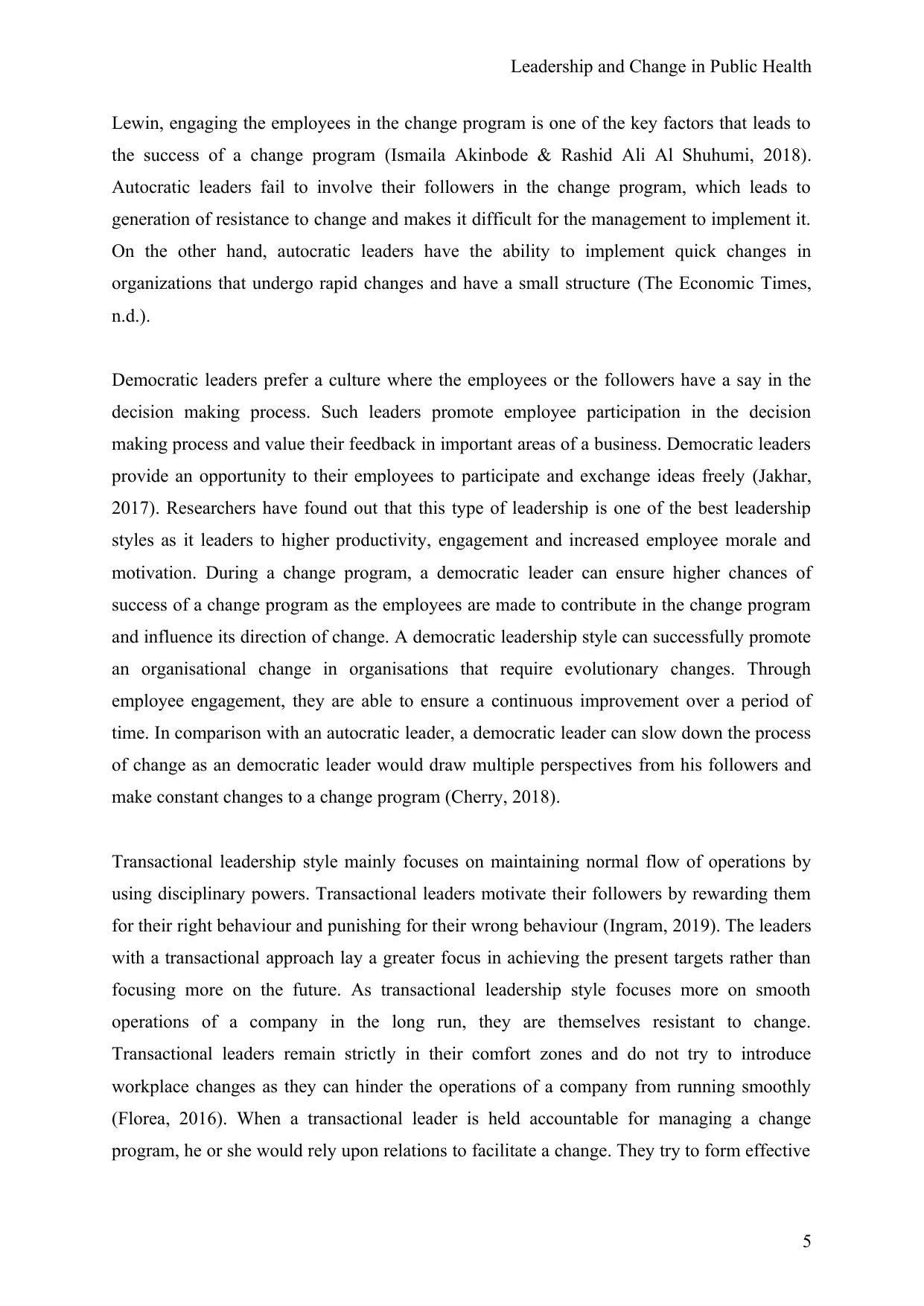
Leadership and Change in Public Health
Lewin, engaging the employees in the change program is one of the key factors that leads to
the success of a change program (Ismaila Akinbode & Rashid Ali Al Shuhumi, 2018).
Autocratic leaders fail to involve their followers in the change program, which leads to
generation of resistance to change and makes it difficult for the management to implement it.
On the other hand, autocratic leaders have the ability to implement quick changes in
organizations that undergo rapid changes and have a small structure (The Economic Times,
n.d.).
Democratic leaders prefer a culture where the employees or the followers have a say in the
decision making process. Such leaders promote employee participation in the decision
making process and value their feedback in important areas of a business. Democratic leaders
provide an opportunity to their employees to participate and exchange ideas freely (Jakhar,
2017). Researchers have found out that this type of leadership is one of the best leadership
styles as it leaders to higher productivity, engagement and increased employee morale and
motivation. During a change program, a democratic leader can ensure higher chances of
success of a change program as the employees are made to contribute in the change program
and influence its direction of change. A democratic leadership style can successfully promote
an organisational change in organisations that require evolutionary changes. Through
employee engagement, they are able to ensure a continuous improvement over a period of
time. In comparison with an autocratic leader, a democratic leader can slow down the process
of change as an democratic leader would draw multiple perspectives from his followers and
make constant changes to a change program (Cherry, 2018).
Transactional leadership style mainly focuses on maintaining normal flow of operations by
using disciplinary powers. Transactional leaders motivate their followers by rewarding them
for their right behaviour and punishing for their wrong behaviour (Ingram, 2019). The leaders
with a transactional approach lay a greater focus in achieving the present targets rather than
focusing more on the future. As transactional leadership style focuses more on smooth
operations of a company in the long run, they are themselves resistant to change.
Transactional leaders remain strictly in their comfort zones and do not try to introduce
workplace changes as they can hinder the operations of a company from running smoothly
(Florea, 2016). When a transactional leader is held accountable for managing a change
program, he or she would rely upon relations to facilitate a change. They try to form effective
5
Lewin, engaging the employees in the change program is one of the key factors that leads to
the success of a change program (Ismaila Akinbode & Rashid Ali Al Shuhumi, 2018).
Autocratic leaders fail to involve their followers in the change program, which leads to
generation of resistance to change and makes it difficult for the management to implement it.
On the other hand, autocratic leaders have the ability to implement quick changes in
organizations that undergo rapid changes and have a small structure (The Economic Times,
n.d.).
Democratic leaders prefer a culture where the employees or the followers have a say in the
decision making process. Such leaders promote employee participation in the decision
making process and value their feedback in important areas of a business. Democratic leaders
provide an opportunity to their employees to participate and exchange ideas freely (Jakhar,
2017). Researchers have found out that this type of leadership is one of the best leadership
styles as it leaders to higher productivity, engagement and increased employee morale and
motivation. During a change program, a democratic leader can ensure higher chances of
success of a change program as the employees are made to contribute in the change program
and influence its direction of change. A democratic leadership style can successfully promote
an organisational change in organisations that require evolutionary changes. Through
employee engagement, they are able to ensure a continuous improvement over a period of
time. In comparison with an autocratic leader, a democratic leader can slow down the process
of change as an democratic leader would draw multiple perspectives from his followers and
make constant changes to a change program (Cherry, 2018).
Transactional leadership style mainly focuses on maintaining normal flow of operations by
using disciplinary powers. Transactional leaders motivate their followers by rewarding them
for their right behaviour and punishing for their wrong behaviour (Ingram, 2019). The leaders
with a transactional approach lay a greater focus in achieving the present targets rather than
focusing more on the future. As transactional leadership style focuses more on smooth
operations of a company in the long run, they are themselves resistant to change.
Transactional leaders remain strictly in their comfort zones and do not try to introduce
workplace changes as they can hinder the operations of a company from running smoothly
(Florea, 2016). When a transactional leader is held accountable for managing a change
program, he or she would rely upon relations to facilitate a change. They try to form effective
5
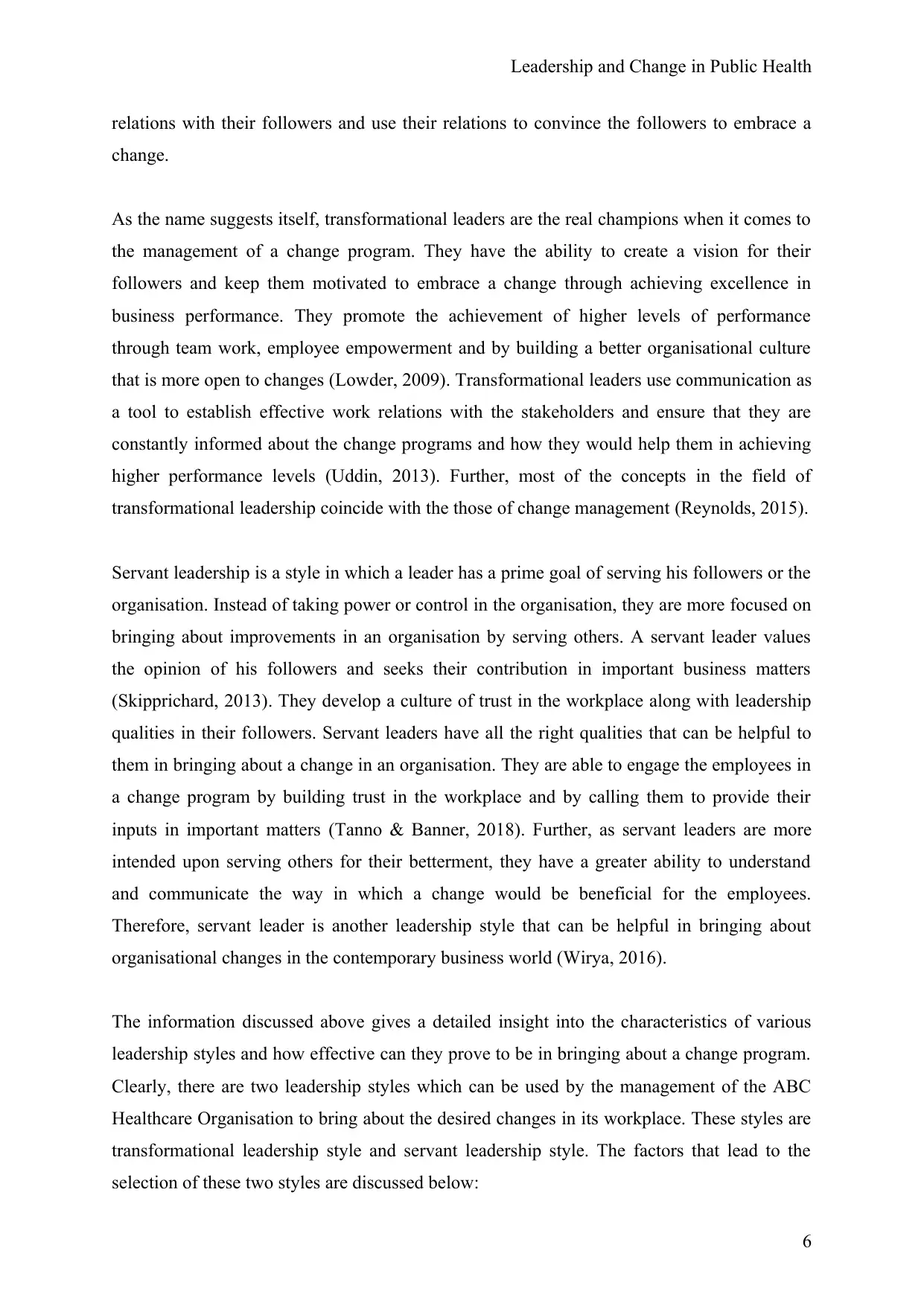
Leadership and Change in Public Health
relations with their followers and use their relations to convince the followers to embrace a
change.
As the name suggests itself, transformational leaders are the real champions when it comes to
the management of a change program. They have the ability to create a vision for their
followers and keep them motivated to embrace a change through achieving excellence in
business performance. They promote the achievement of higher levels of performance
through team work, employee empowerment and by building a better organisational culture
that is more open to changes (Lowder, 2009). Transformational leaders use communication as
a tool to establish effective work relations with the stakeholders and ensure that they are
constantly informed about the change programs and how they would help them in achieving
higher performance levels (Uddin, 2013). Further, most of the concepts in the field of
transformational leadership coincide with the those of change management (Reynolds, 2015).
Servant leadership is a style in which a leader has a prime goal of serving his followers or the
organisation. Instead of taking power or control in the organisation, they are more focused on
bringing about improvements in an organisation by serving others. A servant leader values
the opinion of his followers and seeks their contribution in important business matters
(Skipprichard, 2013). They develop a culture of trust in the workplace along with leadership
qualities in their followers. Servant leaders have all the right qualities that can be helpful to
them in bringing about a change in an organisation. They are able to engage the employees in
a change program by building trust in the workplace and by calling them to provide their
inputs in important matters (Tanno & Banner, 2018). Further, as servant leaders are more
intended upon serving others for their betterment, they have a greater ability to understand
and communicate the way in which a change would be beneficial for the employees.
Therefore, servant leader is another leadership style that can be helpful in bringing about
organisational changes in the contemporary business world (Wirya, 2016).
The information discussed above gives a detailed insight into the characteristics of various
leadership styles and how effective can they prove to be in bringing about a change program.
Clearly, there are two leadership styles which can be used by the management of the ABC
Healthcare Organisation to bring about the desired changes in its workplace. These styles are
transformational leadership style and servant leadership style. The factors that lead to the
selection of these two styles are discussed below:
6
relations with their followers and use their relations to convince the followers to embrace a
change.
As the name suggests itself, transformational leaders are the real champions when it comes to
the management of a change program. They have the ability to create a vision for their
followers and keep them motivated to embrace a change through achieving excellence in
business performance. They promote the achievement of higher levels of performance
through team work, employee empowerment and by building a better organisational culture
that is more open to changes (Lowder, 2009). Transformational leaders use communication as
a tool to establish effective work relations with the stakeholders and ensure that they are
constantly informed about the change programs and how they would help them in achieving
higher performance levels (Uddin, 2013). Further, most of the concepts in the field of
transformational leadership coincide with the those of change management (Reynolds, 2015).
Servant leadership is a style in which a leader has a prime goal of serving his followers or the
organisation. Instead of taking power or control in the organisation, they are more focused on
bringing about improvements in an organisation by serving others. A servant leader values
the opinion of his followers and seeks their contribution in important business matters
(Skipprichard, 2013). They develop a culture of trust in the workplace along with leadership
qualities in their followers. Servant leaders have all the right qualities that can be helpful to
them in bringing about a change in an organisation. They are able to engage the employees in
a change program by building trust in the workplace and by calling them to provide their
inputs in important matters (Tanno & Banner, 2018). Further, as servant leaders are more
intended upon serving others for their betterment, they have a greater ability to understand
and communicate the way in which a change would be beneficial for the employees.
Therefore, servant leader is another leadership style that can be helpful in bringing about
organisational changes in the contemporary business world (Wirya, 2016).
The information discussed above gives a detailed insight into the characteristics of various
leadership styles and how effective can they prove to be in bringing about a change program.
Clearly, there are two leadership styles which can be used by the management of the ABC
Healthcare Organisation to bring about the desired changes in its workplace. These styles are
transformational leadership style and servant leadership style. The factors that lead to the
selection of these two styles are discussed below:
6
⊘ This is a preview!⊘
Do you want full access?
Subscribe today to unlock all pages.

Trusted by 1+ million students worldwide
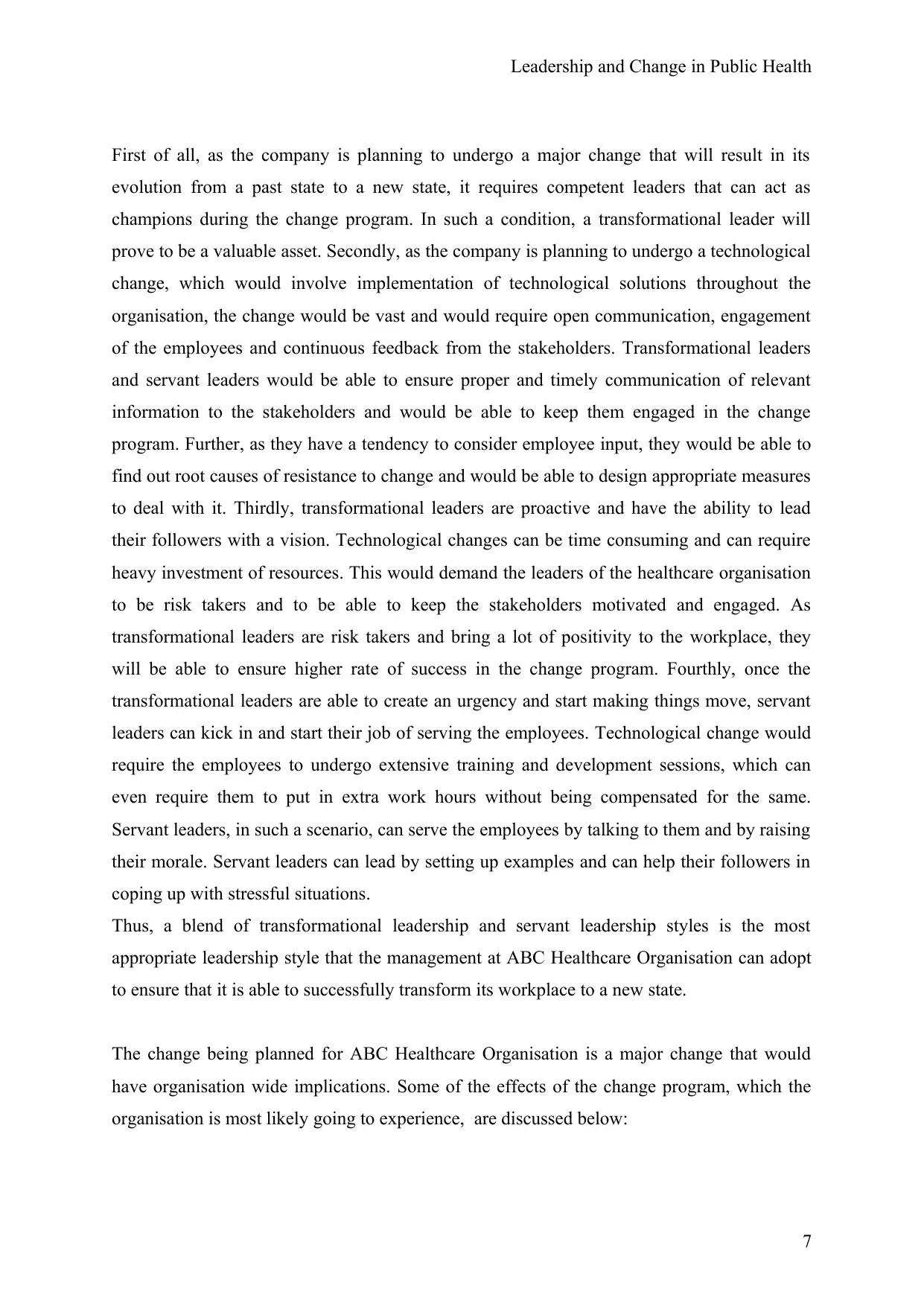
Leadership and Change in Public Health
First of all, as the company is planning to undergo a major change that will result in its
evolution from a past state to a new state, it requires competent leaders that can act as
champions during the change program. In such a condition, a transformational leader will
prove to be a valuable asset. Secondly, as the company is planning to undergo a technological
change, which would involve implementation of technological solutions throughout the
organisation, the change would be vast and would require open communication, engagement
of the employees and continuous feedback from the stakeholders. Transformational leaders
and servant leaders would be able to ensure proper and timely communication of relevant
information to the stakeholders and would be able to keep them engaged in the change
program. Further, as they have a tendency to consider employee input, they would be able to
find out root causes of resistance to change and would be able to design appropriate measures
to deal with it. Thirdly, transformational leaders are proactive and have the ability to lead
their followers with a vision. Technological changes can be time consuming and can require
heavy investment of resources. This would demand the leaders of the healthcare organisation
to be risk takers and to be able to keep the stakeholders motivated and engaged. As
transformational leaders are risk takers and bring a lot of positivity to the workplace, they
will be able to ensure higher rate of success in the change program. Fourthly, once the
transformational leaders are able to create an urgency and start making things move, servant
leaders can kick in and start their job of serving the employees. Technological change would
require the employees to undergo extensive training and development sessions, which can
even require them to put in extra work hours without being compensated for the same.
Servant leaders, in such a scenario, can serve the employees by talking to them and by raising
their morale. Servant leaders can lead by setting up examples and can help their followers in
coping up with stressful situations.
Thus, a blend of transformational leadership and servant leadership styles is the most
appropriate leadership style that the management at ABC Healthcare Organisation can adopt
to ensure that it is able to successfully transform its workplace to a new state.
The change being planned for ABC Healthcare Organisation is a major change that would
have organisation wide implications. Some of the effects of the change program, which the
organisation is most likely going to experience, are discussed below:
7
First of all, as the company is planning to undergo a major change that will result in its
evolution from a past state to a new state, it requires competent leaders that can act as
champions during the change program. In such a condition, a transformational leader will
prove to be a valuable asset. Secondly, as the company is planning to undergo a technological
change, which would involve implementation of technological solutions throughout the
organisation, the change would be vast and would require open communication, engagement
of the employees and continuous feedback from the stakeholders. Transformational leaders
and servant leaders would be able to ensure proper and timely communication of relevant
information to the stakeholders and would be able to keep them engaged in the change
program. Further, as they have a tendency to consider employee input, they would be able to
find out root causes of resistance to change and would be able to design appropriate measures
to deal with it. Thirdly, transformational leaders are proactive and have the ability to lead
their followers with a vision. Technological changes can be time consuming and can require
heavy investment of resources. This would demand the leaders of the healthcare organisation
to be risk takers and to be able to keep the stakeholders motivated and engaged. As
transformational leaders are risk takers and bring a lot of positivity to the workplace, they
will be able to ensure higher rate of success in the change program. Fourthly, once the
transformational leaders are able to create an urgency and start making things move, servant
leaders can kick in and start their job of serving the employees. Technological change would
require the employees to undergo extensive training and development sessions, which can
even require them to put in extra work hours without being compensated for the same.
Servant leaders, in such a scenario, can serve the employees by talking to them and by raising
their morale. Servant leaders can lead by setting up examples and can help their followers in
coping up with stressful situations.
Thus, a blend of transformational leadership and servant leadership styles is the most
appropriate leadership style that the management at ABC Healthcare Organisation can adopt
to ensure that it is able to successfully transform its workplace to a new state.
The change being planned for ABC Healthcare Organisation is a major change that would
have organisation wide implications. Some of the effects of the change program, which the
organisation is most likely going to experience, are discussed below:
7
Paraphrase This Document
Need a fresh take? Get an instant paraphrase of this document with our AI Paraphraser
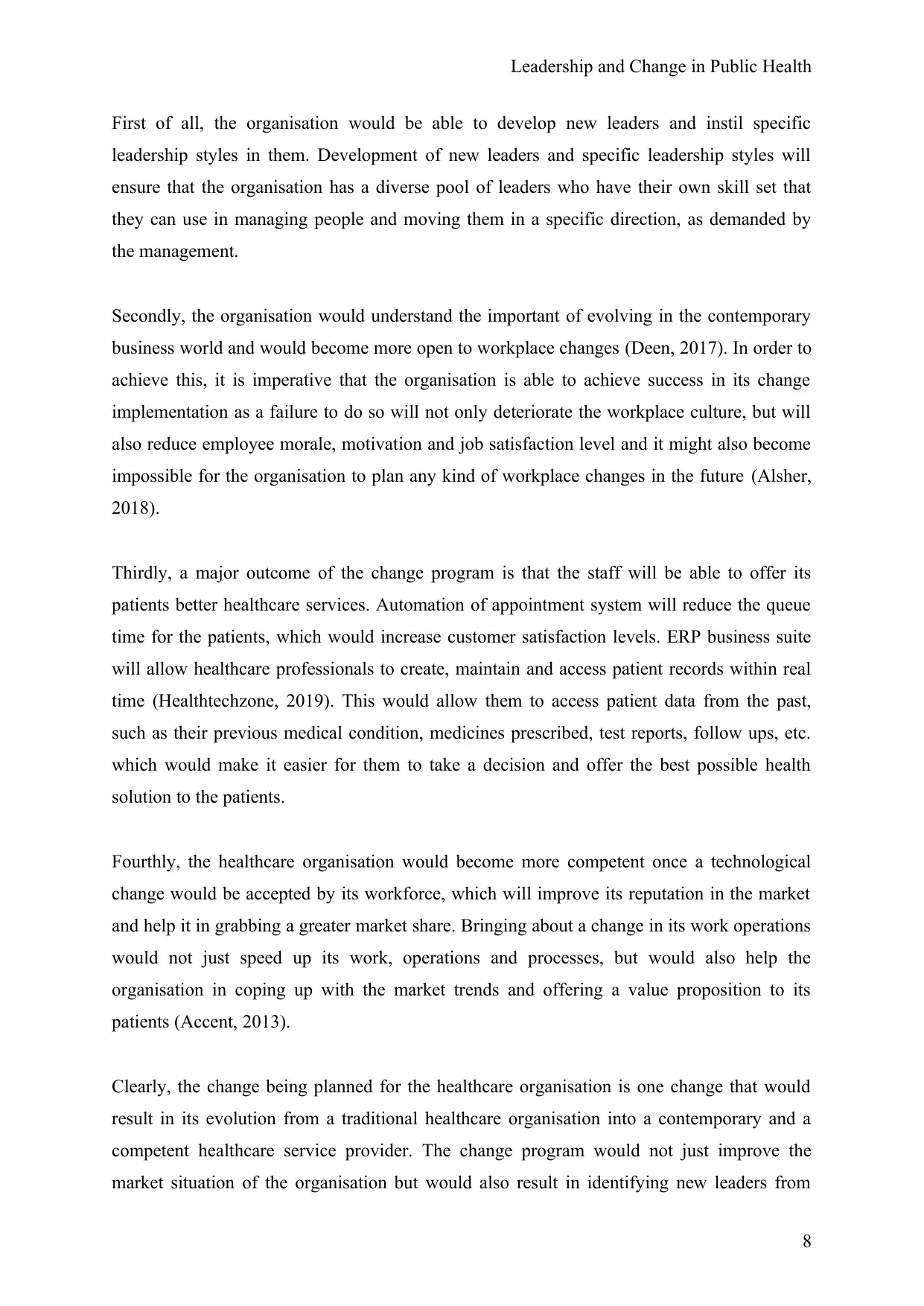
Leadership and Change in Public Health
First of all, the organisation would be able to develop new leaders and instil specific
leadership styles in them. Development of new leaders and specific leadership styles will
ensure that the organisation has a diverse pool of leaders who have their own skill set that
they can use in managing people and moving them in a specific direction, as demanded by
the management.
Secondly, the organisation would understand the important of evolving in the contemporary
business world and would become more open to workplace changes (Deen, 2017). In order to
achieve this, it is imperative that the organisation is able to achieve success in its change
implementation as a failure to do so will not only deteriorate the workplace culture, but will
also reduce employee morale, motivation and job satisfaction level and it might also become
impossible for the organisation to plan any kind of workplace changes in the future (Alsher,
2018).
Thirdly, a major outcome of the change program is that the staff will be able to offer its
patients better healthcare services. Automation of appointment system will reduce the queue
time for the patients, which would increase customer satisfaction levels. ERP business suite
will allow healthcare professionals to create, maintain and access patient records within real
time (Healthtechzone, 2019). This would allow them to access patient data from the past,
such as their previous medical condition, medicines prescribed, test reports, follow ups, etc.
which would make it easier for them to take a decision and offer the best possible health
solution to the patients.
Fourthly, the healthcare organisation would become more competent once a technological
change would be accepted by its workforce, which will improve its reputation in the market
and help it in grabbing a greater market share. Bringing about a change in its work operations
would not just speed up its work, operations and processes, but would also help the
organisation in coping up with the market trends and offering a value proposition to its
patients (Accent, 2013).
Clearly, the change being planned for the healthcare organisation is one change that would
result in its evolution from a traditional healthcare organisation into a contemporary and a
competent healthcare service provider. The change program would not just improve the
market situation of the organisation but would also result in identifying new leaders from
8
First of all, the organisation would be able to develop new leaders and instil specific
leadership styles in them. Development of new leaders and specific leadership styles will
ensure that the organisation has a diverse pool of leaders who have their own skill set that
they can use in managing people and moving them in a specific direction, as demanded by
the management.
Secondly, the organisation would understand the important of evolving in the contemporary
business world and would become more open to workplace changes (Deen, 2017). In order to
achieve this, it is imperative that the organisation is able to achieve success in its change
implementation as a failure to do so will not only deteriorate the workplace culture, but will
also reduce employee morale, motivation and job satisfaction level and it might also become
impossible for the organisation to plan any kind of workplace changes in the future (Alsher,
2018).
Thirdly, a major outcome of the change program is that the staff will be able to offer its
patients better healthcare services. Automation of appointment system will reduce the queue
time for the patients, which would increase customer satisfaction levels. ERP business suite
will allow healthcare professionals to create, maintain and access patient records within real
time (Healthtechzone, 2019). This would allow them to access patient data from the past,
such as their previous medical condition, medicines prescribed, test reports, follow ups, etc.
which would make it easier for them to take a decision and offer the best possible health
solution to the patients.
Fourthly, the healthcare organisation would become more competent once a technological
change would be accepted by its workforce, which will improve its reputation in the market
and help it in grabbing a greater market share. Bringing about a change in its work operations
would not just speed up its work, operations and processes, but would also help the
organisation in coping up with the market trends and offering a value proposition to its
patients (Accent, 2013).
Clearly, the change being planned for the healthcare organisation is one change that would
result in its evolution from a traditional healthcare organisation into a contemporary and a
competent healthcare service provider. The change program would not just improve the
market situation of the organisation but would also result in identifying new leaders from
8
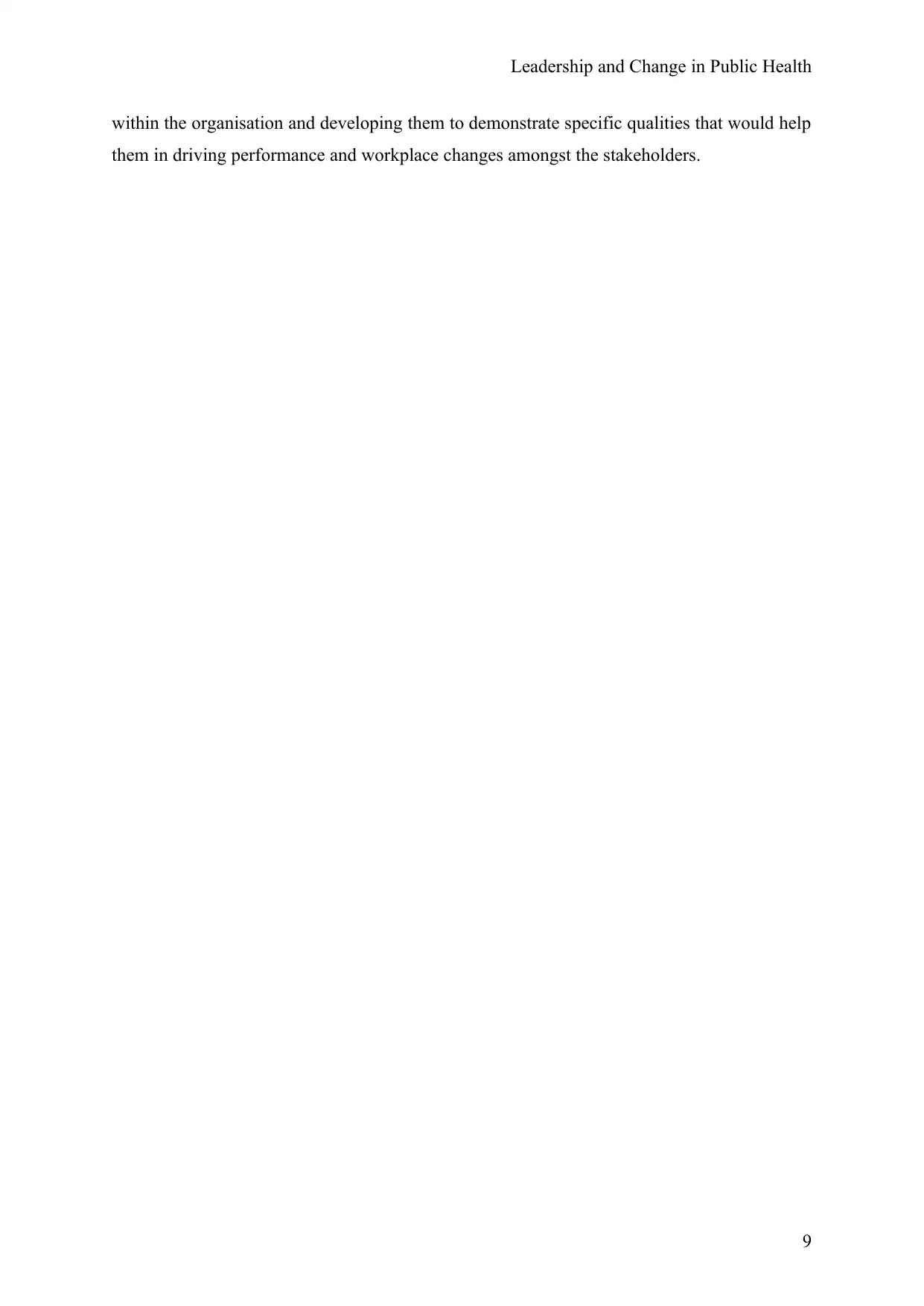
Leadership and Change in Public Health
within the organisation and developing them to demonstrate specific qualities that would help
them in driving performance and workplace changes amongst the stakeholders.
9
within the organisation and developing them to demonstrate specific qualities that would help
them in driving performance and workplace changes amongst the stakeholders.
9
⊘ This is a preview!⊘
Do you want full access?
Subscribe today to unlock all pages.

Trusted by 1+ million students worldwide
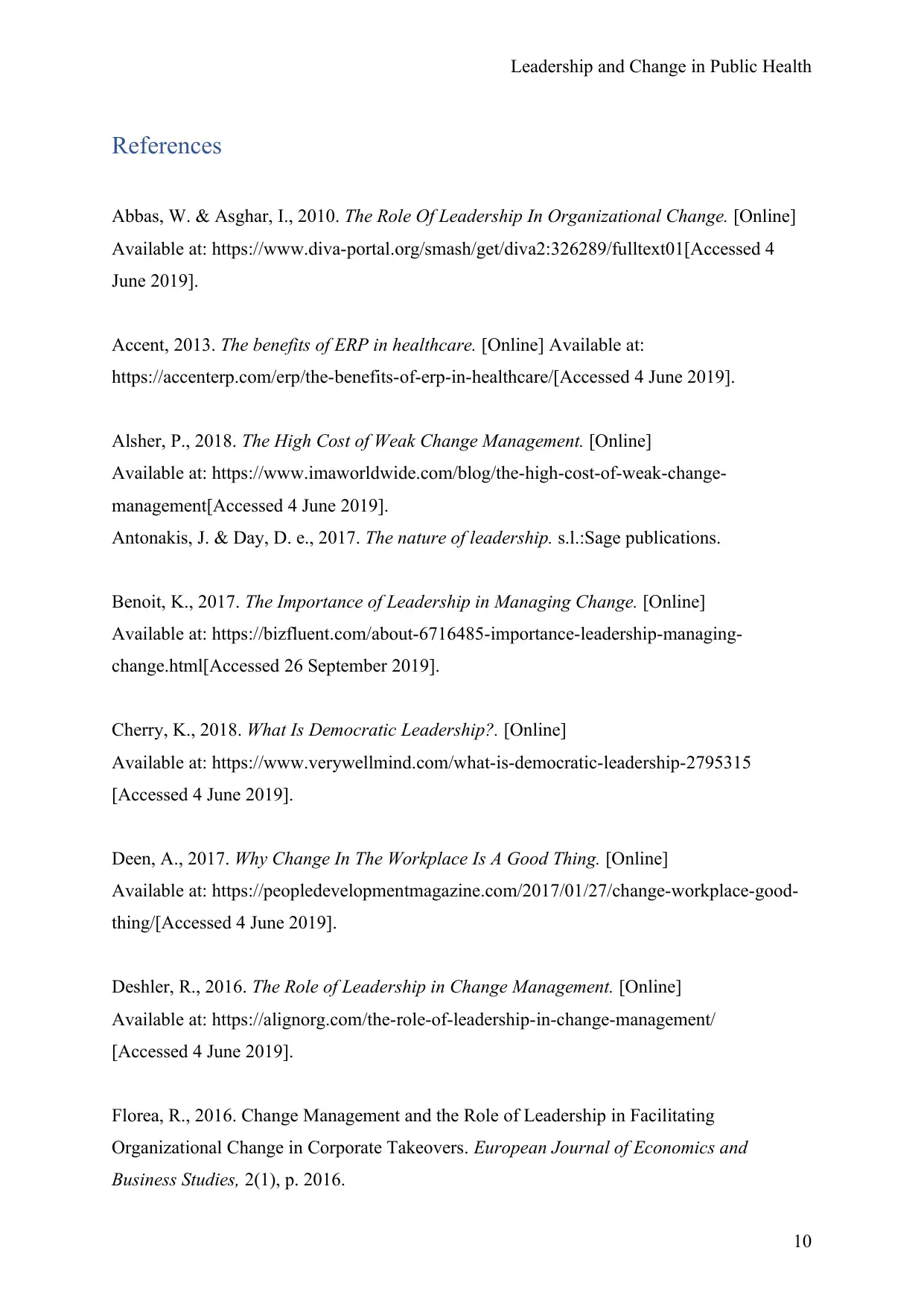
Leadership and Change in Public Health
References
Abbas, W. & Asghar, I., 2010. The Role Of Leadership In Organizational Change. [Online]
Available at: https://www.diva-portal.org/smash/get/diva2:326289/fulltext01[Accessed 4
June 2019].
Accent, 2013. The benefits of ERP in healthcare. [Online] Available at:
https://accenterp.com/erp/the-benefits-of-erp-in-healthcare/[Accessed 4 June 2019].
Alsher, P., 2018. The High Cost of Weak Change Management. [Online]
Available at: https://www.imaworldwide.com/blog/the-high-cost-of-weak-change-
management[Accessed 4 June 2019].
Antonakis, J. & Day, D. e., 2017. The nature of leadership. s.l.:Sage publications.
Benoit, K., 2017. The Importance of Leadership in Managing Change. [Online]
Available at: https://bizfluent.com/about-6716485-importance-leadership-managing-
change.html[Accessed 26 September 2019].
Cherry, K., 2018. What Is Democratic Leadership?. [Online]
Available at: https://www.verywellmind.com/what-is-democratic-leadership-2795315
[Accessed 4 June 2019].
Deen, A., 2017. Why Change In The Workplace Is A Good Thing. [Online]
Available at: https://peopledevelopmentmagazine.com/2017/01/27/change-workplace-good-
thing/[Accessed 4 June 2019].
Deshler, R., 2016. The Role of Leadership in Change Management. [Online]
Available at: https://alignorg.com/the-role-of-leadership-in-change-management/
[Accessed 4 June 2019].
Florea, R., 2016. Change Management and the Role of Leadership in Facilitating
Organizational Change in Corporate Takeovers. European Journal of Economics and
Business Studies, 2(1), p. 2016.
10
References
Abbas, W. & Asghar, I., 2010. The Role Of Leadership In Organizational Change. [Online]
Available at: https://www.diva-portal.org/smash/get/diva2:326289/fulltext01[Accessed 4
June 2019].
Accent, 2013. The benefits of ERP in healthcare. [Online] Available at:
https://accenterp.com/erp/the-benefits-of-erp-in-healthcare/[Accessed 4 June 2019].
Alsher, P., 2018. The High Cost of Weak Change Management. [Online]
Available at: https://www.imaworldwide.com/blog/the-high-cost-of-weak-change-
management[Accessed 4 June 2019].
Antonakis, J. & Day, D. e., 2017. The nature of leadership. s.l.:Sage publications.
Benoit, K., 2017. The Importance of Leadership in Managing Change. [Online]
Available at: https://bizfluent.com/about-6716485-importance-leadership-managing-
change.html[Accessed 26 September 2019].
Cherry, K., 2018. What Is Democratic Leadership?. [Online]
Available at: https://www.verywellmind.com/what-is-democratic-leadership-2795315
[Accessed 4 June 2019].
Deen, A., 2017. Why Change In The Workplace Is A Good Thing. [Online]
Available at: https://peopledevelopmentmagazine.com/2017/01/27/change-workplace-good-
thing/[Accessed 4 June 2019].
Deshler, R., 2016. The Role of Leadership in Change Management. [Online]
Available at: https://alignorg.com/the-role-of-leadership-in-change-management/
[Accessed 4 June 2019].
Florea, R., 2016. Change Management and the Role of Leadership in Facilitating
Organizational Change in Corporate Takeovers. European Journal of Economics and
Business Studies, 2(1), p. 2016.
10
Paraphrase This Document
Need a fresh take? Get an instant paraphrase of this document with our AI Paraphraser
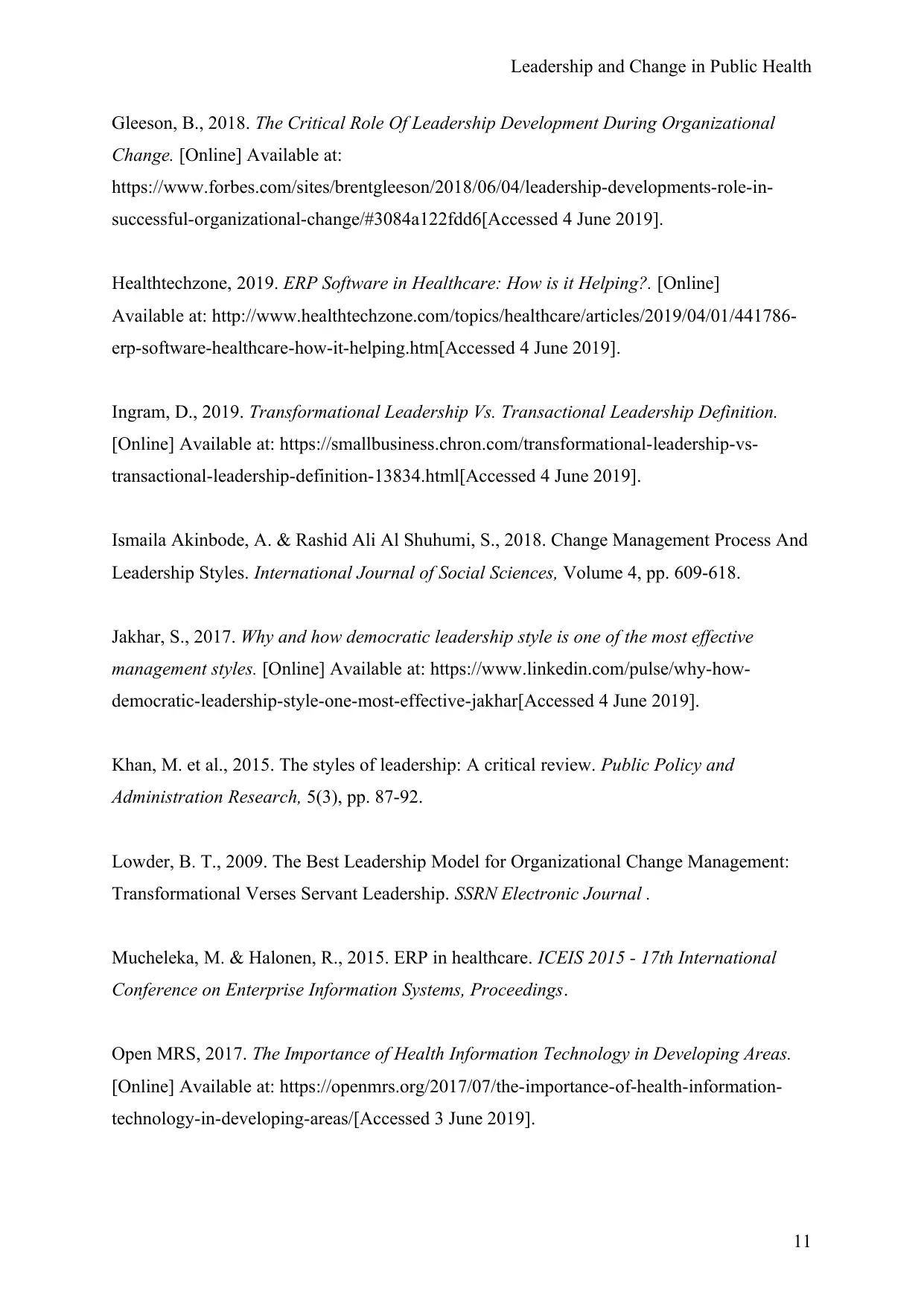
Leadership and Change in Public Health
Gleeson, B., 2018. The Critical Role Of Leadership Development During Organizational
Change. [Online] Available at:
https://www.forbes.com/sites/brentgleeson/2018/06/04/leadership-developments-role-in-
successful-organizational-change/#3084a122fdd6[Accessed 4 June 2019].
Healthtechzone, 2019. ERP Software in Healthcare: How is it Helping?. [Online]
Available at: http://www.healthtechzone.com/topics/healthcare/articles/2019/04/01/441786-
erp-software-healthcare-how-it-helping.htm[Accessed 4 June 2019].
Ingram, D., 2019. Transformational Leadership Vs. Transactional Leadership Definition.
[Online] Available at: https://smallbusiness.chron.com/transformational-leadership-vs-
transactional-leadership-definition-13834.html[Accessed 4 June 2019].
Ismaila Akinbode, A. & Rashid Ali Al Shuhumi, S., 2018. Change Management Process And
Leadership Styles. International Journal of Social Sciences, Volume 4, pp. 609-618.
Jakhar, S., 2017. Why and how democratic leadership style is one of the most effective
management styles. [Online] Available at: https://www.linkedin.com/pulse/why-how-
democratic-leadership-style-one-most-effective-jakhar[Accessed 4 June 2019].
Khan, M. et al., 2015. The styles of leadership: A critical review. Public Policy and
Administration Research, 5(3), pp. 87-92.
Lowder, B. T., 2009. The Best Leadership Model for Organizational Change Management:
Transformational Verses Servant Leadership. SSRN Electronic Journal .
Mucheleka, M. & Halonen, R., 2015. ERP in healthcare. ICEIS 2015 - 17th International
Conference on Enterprise Information Systems, Proceedings.
Open MRS, 2017. The Importance of Health Information Technology in Developing Areas.
[Online] Available at: https://openmrs.org/2017/07/the-importance-of-health-information-
technology-in-developing-areas/[Accessed 3 June 2019].
11
Gleeson, B., 2018. The Critical Role Of Leadership Development During Organizational
Change. [Online] Available at:
https://www.forbes.com/sites/brentgleeson/2018/06/04/leadership-developments-role-in-
successful-organizational-change/#3084a122fdd6[Accessed 4 June 2019].
Healthtechzone, 2019. ERP Software in Healthcare: How is it Helping?. [Online]
Available at: http://www.healthtechzone.com/topics/healthcare/articles/2019/04/01/441786-
erp-software-healthcare-how-it-helping.htm[Accessed 4 June 2019].
Ingram, D., 2019. Transformational Leadership Vs. Transactional Leadership Definition.
[Online] Available at: https://smallbusiness.chron.com/transformational-leadership-vs-
transactional-leadership-definition-13834.html[Accessed 4 June 2019].
Ismaila Akinbode, A. & Rashid Ali Al Shuhumi, S., 2018. Change Management Process And
Leadership Styles. International Journal of Social Sciences, Volume 4, pp. 609-618.
Jakhar, S., 2017. Why and how democratic leadership style is one of the most effective
management styles. [Online] Available at: https://www.linkedin.com/pulse/why-how-
democratic-leadership-style-one-most-effective-jakhar[Accessed 4 June 2019].
Khan, M. et al., 2015. The styles of leadership: A critical review. Public Policy and
Administration Research, 5(3), pp. 87-92.
Lowder, B. T., 2009. The Best Leadership Model for Organizational Change Management:
Transformational Verses Servant Leadership. SSRN Electronic Journal .
Mucheleka, M. & Halonen, R., 2015. ERP in healthcare. ICEIS 2015 - 17th International
Conference on Enterprise Information Systems, Proceedings.
Open MRS, 2017. The Importance of Health Information Technology in Developing Areas.
[Online] Available at: https://openmrs.org/2017/07/the-importance-of-health-information-
technology-in-developing-areas/[Accessed 3 June 2019].
11
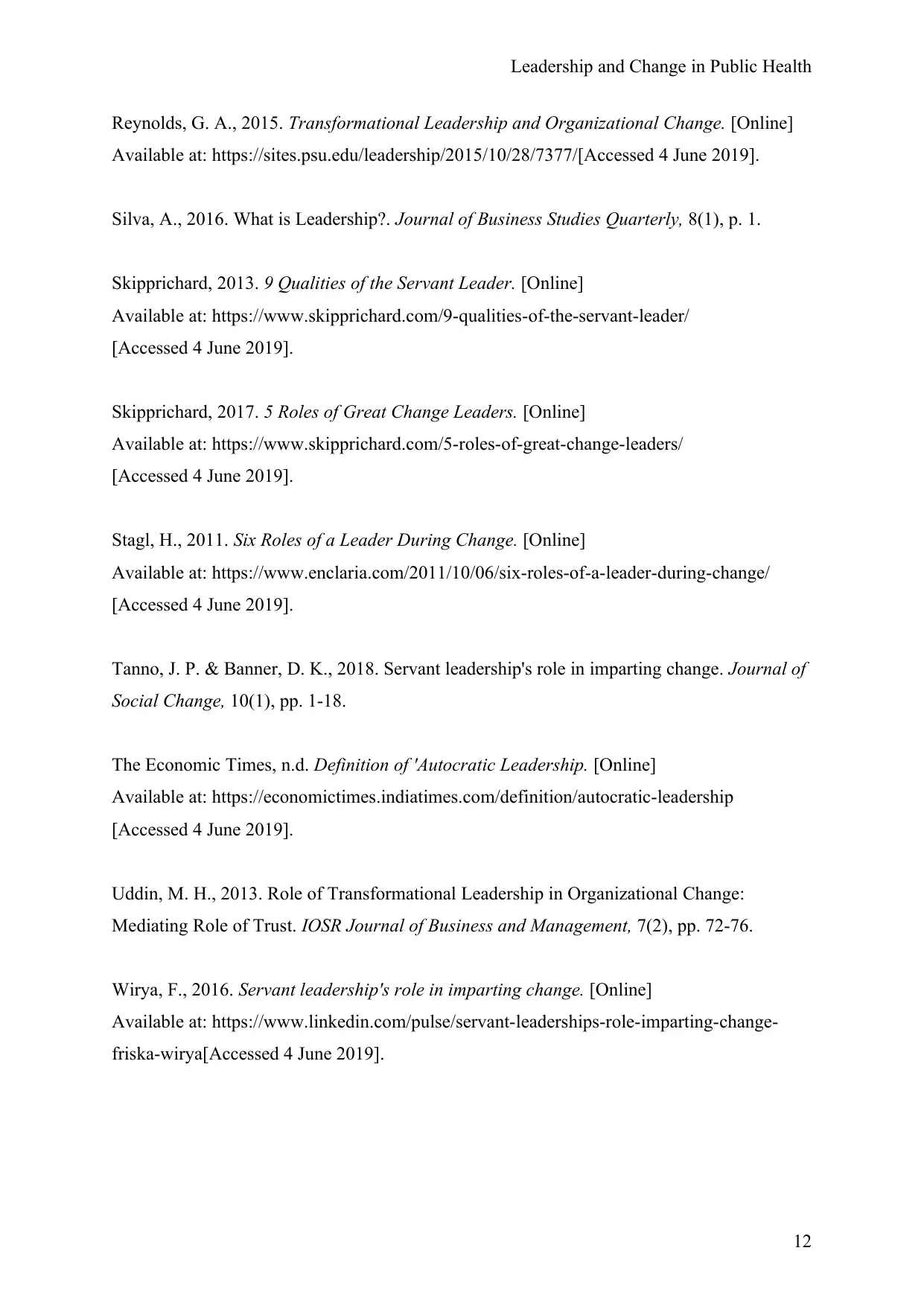
Leadership and Change in Public Health
Reynolds, G. A., 2015. Transformational Leadership and Organizational Change. [Online]
Available at: https://sites.psu.edu/leadership/2015/10/28/7377/[Accessed 4 June 2019].
Silva, A., 2016. What is Leadership?. Journal of Business Studies Quarterly, 8(1), p. 1.
Skipprichard, 2013. 9 Qualities of the Servant Leader. [Online]
Available at: https://www.skipprichard.com/9-qualities-of-the-servant-leader/
[Accessed 4 June 2019].
Skipprichard, 2017. 5 Roles of Great Change Leaders. [Online]
Available at: https://www.skipprichard.com/5-roles-of-great-change-leaders/
[Accessed 4 June 2019].
Stagl, H., 2011. Six Roles of a Leader During Change. [Online]
Available at: https://www.enclaria.com/2011/10/06/six-roles-of-a-leader-during-change/
[Accessed 4 June 2019].
Tanno, J. P. & Banner, D. K., 2018. Servant leadership's role in imparting change. Journal of
Social Change, 10(1), pp. 1-18.
The Economic Times, n.d. Definition of 'Autocratic Leadership. [Online]
Available at: https://economictimes.indiatimes.com/definition/autocratic-leadership
[Accessed 4 June 2019].
Uddin, M. H., 2013. Role of Transformational Leadership in Organizational Change:
Mediating Role of Trust. IOSR Journal of Business and Management, 7(2), pp. 72-76.
Wirya, F., 2016. Servant leadership's role in imparting change. [Online]
Available at: https://www.linkedin.com/pulse/servant-leaderships-role-imparting-change-
friska-wirya[Accessed 4 June 2019].
12
Reynolds, G. A., 2015. Transformational Leadership and Organizational Change. [Online]
Available at: https://sites.psu.edu/leadership/2015/10/28/7377/[Accessed 4 June 2019].
Silva, A., 2016. What is Leadership?. Journal of Business Studies Quarterly, 8(1), p. 1.
Skipprichard, 2013. 9 Qualities of the Servant Leader. [Online]
Available at: https://www.skipprichard.com/9-qualities-of-the-servant-leader/
[Accessed 4 June 2019].
Skipprichard, 2017. 5 Roles of Great Change Leaders. [Online]
Available at: https://www.skipprichard.com/5-roles-of-great-change-leaders/
[Accessed 4 June 2019].
Stagl, H., 2011. Six Roles of a Leader During Change. [Online]
Available at: https://www.enclaria.com/2011/10/06/six-roles-of-a-leader-during-change/
[Accessed 4 June 2019].
Tanno, J. P. & Banner, D. K., 2018. Servant leadership's role in imparting change. Journal of
Social Change, 10(1), pp. 1-18.
The Economic Times, n.d. Definition of 'Autocratic Leadership. [Online]
Available at: https://economictimes.indiatimes.com/definition/autocratic-leadership
[Accessed 4 June 2019].
Uddin, M. H., 2013. Role of Transformational Leadership in Organizational Change:
Mediating Role of Trust. IOSR Journal of Business and Management, 7(2), pp. 72-76.
Wirya, F., 2016. Servant leadership's role in imparting change. [Online]
Available at: https://www.linkedin.com/pulse/servant-leaderships-role-imparting-change-
friska-wirya[Accessed 4 June 2019].
12
⊘ This is a preview!⊘
Do you want full access?
Subscribe today to unlock all pages.

Trusted by 1+ million students worldwide
1 out of 12
Related Documents
Your All-in-One AI-Powered Toolkit for Academic Success.
+13062052269
info@desklib.com
Available 24*7 on WhatsApp / Email
![[object Object]](/_next/static/media/star-bottom.7253800d.svg)
Unlock your academic potential
Copyright © 2020–2025 A2Z Services. All Rights Reserved. Developed and managed by ZUCOL.





